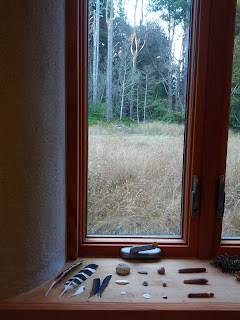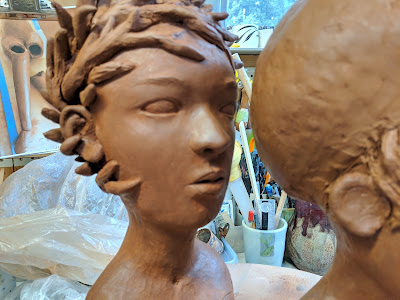 |
| autumn morning--collection of various things found on walks |
All summer we have gone up the coast, down
the coast, inland and back. We built sand castles, made sandy fishtails
on our giggling grand-children's legs (yes, their legs were giggling :)
Eating candy cap mushroom ice cream at Cowlick's and watching the boys'
eyebrows go up in amazement that mushrooms could taste so good. We
waded in a stream, once a river, showing kids how to patiently
wait and simply look with no expectations. Then to finally see little
minnows swimming about--so magically appearing that the six year old
gleefully whispered look!look, MoMo--the invisible fish are there and there and there...hello...hello. Is that how mermaids look when they are first born?

Carving
porcelain is so much easier than wood. Still there is something about
making a simple wood spoon. Back in the B.C. (before clay) I carved in
stone and wood. Wood carving was mainly for woodblock printing and
scroll work, never a thought to carve a spoon. It was time, this
summer, when half the studio was packed up and moved and stored. My hands needed to
make something light, something that took time and quiet reflection.
 |
| walnut scrap |
 |
| far left spoon first one carved (white alder) |
I wanted to just carve with my own strength, no assistance
from power tools. I used a coping saw to cut out a free form shape.
Small chisels to take away chunks. A hook blade and spoon gouge to form
the bowl---scraping little curls---the sound---musical notes that tell
me that the blade is sharp and true. It takes time, stopping to strop
the knives and stretching fingers. After a bit of practice, it was time for larger spoon. A piece of walnut, a gift from Herr (ah, he knows the way to this woman's heart!) When the spoon was done, it needed a
bit of sanding and finally some wood butter to make it satiny smooth. It's
big but light in weight. Just like a mermaid's heart.







sounds like a wonderful summer of fun, what patience, walnut is a very hard wood, good for you
ReplyDeleteWalnut is hard, but it really has a buttery feel. I soaked it in a solution of water and denatured alcohol for an hour to soften it.
DeleteI just love this post. Reading about sharing hearts and discoveries. -- giggling legs! and Ooooh I would love to see the invisible fish - could be the beginning of a mermaid. And your description of carving spoons -- almost -- made me want to run out and get my own wood and carving tools . . .maybe not. Your spoons are luscious! Good project for idle hands.
ReplyDeleteThis spoon is destined to stir big pot of Japanese style curry. Yum! The little alder ones are going into little jam jars that are next on the clay agenda :)
DeleteThere is a quiet, calm, softness in your words here, Charlene. And they are beautiful.
ReplyDeleteEven without pictures, I could see and feel the lightness.
Wood carving does take us to a deep, meditative, yet somehow subconsciously alert place. A place when we know "enough".
And, it is immensely satisfying.
Such a stunning piece of walnut. Perfect.
Your spoons are just so lovely. And the large one warms my heart. I can see, without even touching its soft, buff surface, the quiet energies and wonderful vibrations carved into, and mingling with, the wood's own life force.
I do so love images of your house. A serene wabi sabi that sings softly to the heart.
And, what a wonderful comment from your sweet grandchild. I like to think that invisible minnows are indeed how mermaids are first born :)
Beautiful magic here.
Nice thing about carving a spoon---once it's done, it's done. Unlike ceramic spoons. On the other hand, ceramic spoons are easy to form ;)
DeleteYou have a lyrical way with words, Vicki.
A year ago I read "The Lost Carving: A Journey to the Heart of Making" by David Esterly. I liked the book and the title. Have you read it?
No, I hadn't heard of it before. But now, I will seek it out.
DeleteI love the title. Any "journey to the heart of making" is very evocative to an artist, no matter their medium. So I think this would be a wonderful book to read. Thank you for the suggestion, Charlene.
It's funny how the Universe works. After seeing your post yesterday, and admiring your beautiful spoons, hubby and I watched a home show last night on TV. They featured "traditional artisans" showcasing their craft and skills - some of which are on the brink of being lost to history, threatened by mass production in our consumerist society.
Only using their hands and the wonderful tools of their trade - many of which are rarely seen these days.
One such artisan was a spoonsmith! As he carved a beautiful, large wooden spoon, those wonderfully rustic chip marks showing its making, a little chill ran through me. And I thought of your spoon.
Synchronicity.
They will hold a "Lost Trades Fair" here in Victoria in March next year and I fully intend to go.
To be immersed in a day among artisans holding dear to their hearts, minds and souls their almost forgotten crafts will be an honour and a joy.
I hope our society will turn once more to these crafts, recognising their importance and appreciate the trades which were the backbone of our culture, learning these time worn skills and keeping them alive, ensuring a (hopefully) more sustainable future.
I love the way the Universe works :)
Artisan made objects make our world more real, more sustainable and reach beyond just functionality and beauty. Skillfully made objects whether a ceramic cup, a wood chair, a woven basket, a hand-stitched quilt, a kimono, a stone basin or dolls connects us to an universal language and history. Yes, I do love the way how we seem to connect, Vicki!
Delete